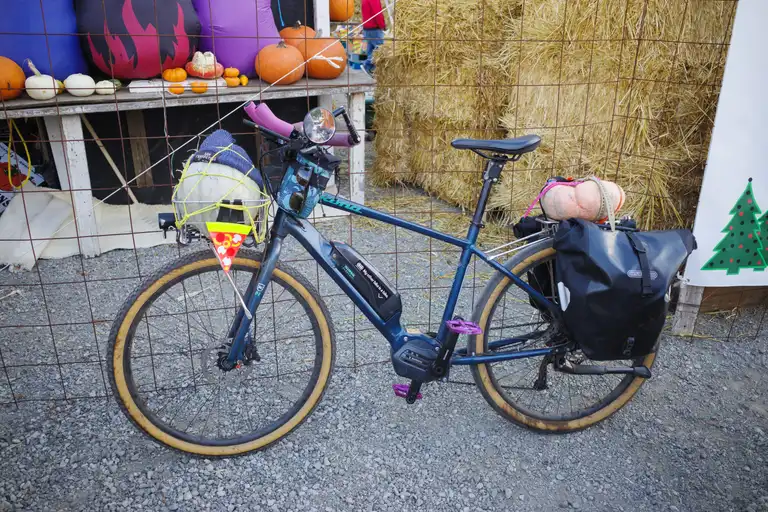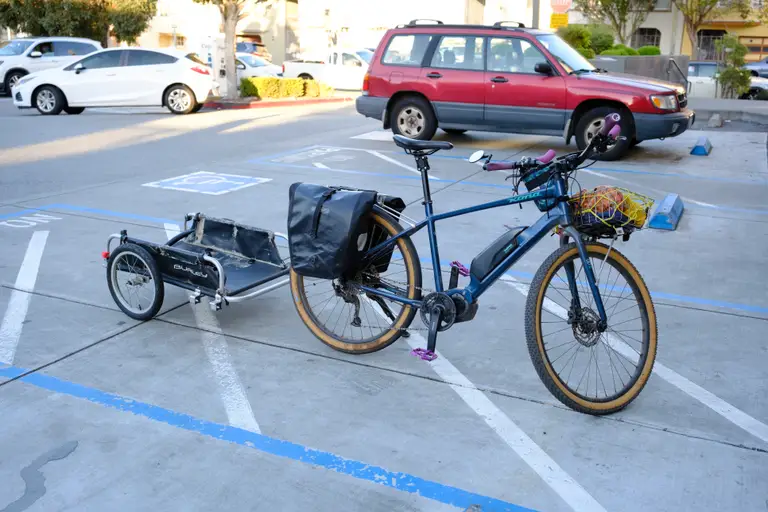Disclaimers
- These are reflections on my Kona Dew-E (egret), which is a mid-drive e-bike. The last section of this post discusses why I chose it.
- This post is a sort of signpost of my thoughts on e-bikes after a few months and I expect many of these thoughts to change.
- I haven’t carried kids or pets on this bike, and it’s not a cargo bike.1
- This has been my do-everything bike for the last three months. I’ve ridden it on and off the road, carried heavy loads up steep San Francisco hills without running out of breath, and attached a Burley trailer to it to get 40 lbs of firewood up to the Presidio. This is well-rounded riding and my opinions are of course based on that, but your riding might be different!
Riding Patterns
- It is an enormous joy riding my e-bike. It feels like a different, non-competing experience with my normal bike.
- I’ll take safer/less trafficked but hillier roads that I wouldn’t take on a normal bike.
- It lets me get around even after a long day or after I’m tired from strength training. I end up riding a lot more as a result. I just went on a Hawk Hill out-and-back on a gym day after work, and picked up dinner on the way back.
- The motor lets you make different bike fit tradeoffs (e.g., a lower saddle position than I’d generally ride which is comfier on the saddle but would be typically less comfy on my joints).2 Even different contact point tradeoffs such as tire choice and pressure.
- On any bike your weight is distributed across all your contact points: handlebars, saddle, and pedals. E-biking can feel like biking at a chill pace on a normal bike. I find that this can result in discomfort faster because less weight is going into your pedals and more into your handlebars and saddle.
- I can carry basically anything! If I carry something for my friends mid-ride I don’t even notice the extra weight. I’ve yet to come upon a hill or load that’s too much for the motor.
- I bought this after over a year of chronic wrist pain affecting nearly every aspect of my life, including riding. Here are some ways I think the e-bike has helped:
- As I fatigue on longer rides (or if I’m already tired when I get on the bike) my core gives less support and I’ll put more weight on my bars and thus my wrists. The motor helps me avoid this situation.
- People often torque their wrists against their bars when climbing hard hills. The e-bike makes hills easier and avoids this more often.
- Pain can have a neuroplastic component, and it’s easy for me to be habitually hypervigilant about pain on the bike. Riding with the electric assist has perhaps shaken up my experience on a bike and given some positive feedback cycle here.
- Similarly, if I am getting a flare-up, I can get home faster which helps avoid negative associations with pain on a bike.
- The great thing about an e-bike is that I can easily carry a beefy lock. I use a Hiplok D1000 with Pitlock locking skewers for the wheels. I generally only lock to inverted-U bike racks.
Assist Experience
- The assist algorithm is very, very good. It feels shockingly natural. It’s much better than the hub-motor bike share e-bikes in San Francisco.
Occasionally I’ll get brief moments where the motor seems to flicker off or is out of parity with my effort.I haven’t totally noticed a pattern with this but it seems to be when my bike is asymmetrically loaded. I’m curious if other e-bike riders get this sometimes. Update: This went away entirely when I switched drivetrains.- It’s surprisingly quiet!
- The drag you feel when the motor assists minimally or not at all could be better. I think I’ve maybe “broken in” mine a bit and the drag feels less bad than it did when I first got the bike. I remember trying the lowest assist level right away and not liking it; now I don’t mind it so much. I may have just gotten used to it.
- The range on this 504 Wh battery is excellent.
- The shifting isn’t great — see my thoughts on this and how it might relate to a non-Linkglide drivetrain.
Maintenance
- Definitely wears through consumables faster. I’ve already gotten to 0.5% wear on this chain.
- Battery management! Regulation and safety for e-bike batteries are a hot topic — these are larger batteries that experience many more load cycles than you would expect to be kept in an apartment building. I follow some guidelines:
- I have a 504 Wh battery that came with the bike and a 630 Wh battery that I got for longer touring. I use the 504 Wh battery for most riding and keep the 630 Wh battery stored in a cool, dark place at 70% charge and then charge it to 100% before a large day ride.
- I try to follow the Bosch guidelines and Shimano guidelines. I would love manufacturers to publish more care information for their batteries to maximize their longevity. Sadly, batteries ultimately don’t last very long compared to the timeline I would like an e-bike to last.
Politics
- Some claim that e-bikes have a lower carbon footprint per mile than a traditional bike since charging the battery uses less energy than producing the calories that would be eaten instead. BikeRadar has some reporting on this. Whether this is true or not I think that a lot of e-bikes will become e-waste and that the mining involved in battery production is terrible for our planet. Getting people on traditional bikes instead of e-bikes should be a goal when possible.
- Many people aren’t well served by the bikes they’re familiar with because the bike industry predominantly sells uncomfortable bikes with low utility and too-hard gears. I still think that many people wouldn’t get an e-bike if they had a regular bike that was comfortable for them, had dynamo lights, and a wide range of gears that were low enough to carry lots of stuff up big hills.
PeopleForBikes Three-Class System
PeopleForBikes has model legislation defining three different classes of e-bikes. Many states here in the US have adopted this three-class system. The tl;dr is this:
- Class 1 assists up to 20 mph only while pedaling.
- Class 2 assists up to 20 mph and has a throttle to assist without pedaling.
- Class 3 assists up to 28 mph only3 while pedaling.
I’ve come to think after 2000 km of riding on this bike that it’s very difficult to justify the existence of class 2 and 3 e-bikes.4 I think there are good accessibility reasons to have a throttle but I’m not convinced it needs to assist as high as 20 mph or be kept on indefinitely. 20 mph is fast. I’ve test-ridden long-tail cargo bikes that assist up to 28 mph and the difference I feel in the power dynamic between myself and other road users is scary.
Appendix: Choosing This Particular E-Bike
I ended up buying a Kona Dew-E. The following factors went into it, in no particular order.
- I could buy a Kona through a local dealer — although Kona just switched to a direct-to-consumer model which I find condemnable.
- I deliberately got an e-bike under 50 lbs so that I could carry it up and down stairs. These are hard to find — especially if you want to avoid carbon frames (as I think one should).
- Shimano or Bosch drivetrains only. This is because I can get their parts through reputable dealers (and in my case, I can get them through the bike shop I’m involved with) and both have a good reputation for reliability and safety.5 Both companies have been around a long time and are unlikely to land you in a VanMoof situation.
- I wanted a mid-drive motor instead of a hub motor because I prefer how it feels to ride and it’s less of an operation to take the wheel in and out.
- The Dew-E is mostly a regular bike that happens to have a motor on it. It’s a Class 1 e-bike and the drivetrain is a typical mechanical drivetrain (other than the motor and crankset, of course) which could be swapped with anything (as I will be doing!). Most maintenance can be done without needing to touch the parts of the bike that make it an e-bike.
- Shimano hydraulic brakes — they require less hand effort, allow me to do single-finger braking,6 require less maintenance, and the pads self-adjust as they wear. I wanted Shimano specifically because they use mineral oil instead of DOT fluid and can be bled with readily available equipment with good documentation on their maintenance.
- No integrated headset/stem/bar situations that make it more difficult to swap contact points. The steerer is a standard threadless 9/8" diameter and the seatpost is a standard 27.2 mm.
- A kickstand and plenty of rack mounts.
- A rigid fork instead of a suspension fork. I find the suspension unnecessary for day-to-day riding with correct tire choice and it avoids their extra weight and maintenance.
- The battery is external, has a keyed lock, and it’s easy to order replacement batteries through a brick-and-mortar bike shop.
- A minimal interface for controlling the motor. This one came with a small screen on the bar beside the stem to read my speed and current assist level. Then a small switch on the left side of my bars lets me rotate through assist choices.
It’s not a long-tail, bakfiet, or other specialized cargo bike. It’s just a standard double-triangle bike with an 1127 mm wheelbase and no integrated racks. ↩︎
My bike fit has drifted back towards what I’d have on a normal bike as I do harder and longer rides on the e-bike. This opinion might be limited to shorter rides. ↩︎
There are also e-bikes, arguably outside California law, which advertise themselves as a Class 3 e-bike but have a throttle that assists up to 20 mph. The three-class system states that Class 3 e-bikes provide “assistance only when the rider is pedaling,” so these probably shouldn’t exist. ↩︎
I would say I have high-medium confidence in this opinion. ↩︎
n.b.: I have not researched this extensively, and it’s mostly an inferred opinion. ↩︎
My understanding is that one finger braking lets you keep a more relaxed grip on the bar. If you relax all your fingers and then bring your index finger towards your palm like you were braking you’ll notice you can still keep your other fingers fairly relaxed. Do the same with your middle finger and you’ll notice it’s hard to relax your ring finger! ↩︎
- Next (): October 2023 Riding Highlights
- Prev (): It’s Fall Y’all! 🎃💦 Time for Fenders

